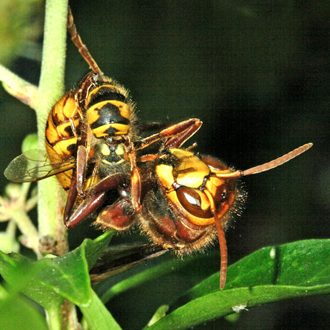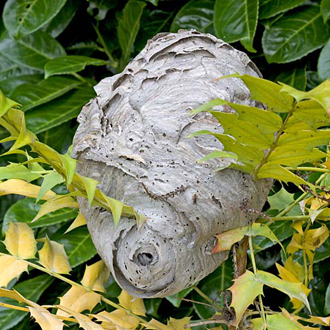
 |
 |
 |
 |

|

|
 |
 |
 |
 |
 |
 |
|
Wasps in general, and social wasps led by the Hornet (Vespa crabro, worker 22mm), Common Wasp (Vespula vulgaris, worker 15mm) and German Wasp (Vespula germanica, worker 16mm) in particular, receive a consistently bad press, described as 'striped hooligans' or worse. They cause trouble at picnics, they nest in your shrubbery, trees or roofs, they get woozy and hide invisibly when drunk from fruit or when cold, they come into any and every room in the house, but mainly - they sting. With the Vespula species in particular this can result in potentially fatal anaphylactic shock for a small proportion of people. None of this is disputable, and it would be an exceptional, or exceptionally But demonising social wasps for doing what comes naturally rather than from any human emotion such as malice is a bit daft, especially when the demonisation is not entirely accurate - generally, wasps in Europe sting defensively to protect themselves if attacked or seriously disturbed, with direct, unprovoked attacks uncommon. Strident newspaper reports in 2005 of the supposed threat posed by a new, giant, aggressive invader were at best dubious, at worst ridiculous. The species, which was not given its scientific name, presumably was Dolichovespula media, which at 19mm is certainly pretty sizeable - larger than Vespula vulgaris and Vespula germanica, for instance - but is not truly a giant. Nor is it new - they have been in Britain for 20 years and are now quite easily seen. As for aggression, they tend not to come indoors as much as the Common Wasp and although some colonies have been known to launch an attack on a person with what was deemed by humans to be little provocation, most are more docile than the Vespula clan. The same applies to Dolichovespula sylvestris, Dolichovespula saxonica and Vespula rufa, though the last-named, while it can nest in eaves, is not so frequent a visitor to urban homes and gardens as the first two. If it is giants you want, look no further than the Hornet. Once seen and heard, never forgotten is a fair summary of the effect of a 30mm queen flying past an observer. The species is by far the largest social wasp in Britain and reasonably common, albeit less so in the southern Home Counties than in such areas as East Anglia and Dorset. Although there is a close association with ancient deciduous woodland, Hornets are found fairly frequently in urban settings. Nests - in trees, underground or in buildings - can be massive, containing up to 1,500 cells which are re-used. As with other social wasps, prey principally consists mainly of Diptera (flies) though other social wasps, honey bees, Lepidoptera and spiders are also taken. Hornets are not inconvenienced by cloudy conditions or even light rain and can hunt on bright nights too. They are also not aggressive, and give humans no trouble unless attacked. Taking the question of predation a little further, the fact that social wasps are prolific at reducing pest species, especially flies, ought to make them popular with gardeners. With upwards of 7,000 cells and hungry larvae in a Common Wasp nest, That's a lot of flies. They also pollinate some plants when nectaring, and their fascinating, intricate and delicate method of nest construction by using wood fibres inspired men generations ago to produce paper from wood pulp. Social wasps including Hornets can get wood for nesting from almost any source including garden fences, as the image above shows, but dead wood is favoured since it is easier to work. This habitat also serves to encourage other species Use of wood gives the The European Paper Wasp (Polistes dominula, 16mm) its name. This is a widespread species that inhabits just about all types of open habitat in Europe, North Africa, the Middle East, and through central Asia to Mongolia. It is also an invasive species in North America, where seemingly it is posing a threat to some indigenous Paper Wasps. The rate of colonisation has been rapid, since the species was first seen in Massachusetts in 1981 and can now be found in California, Oregon and Washington on the other side of the continent. Migrant, or accidentally imported, Paper Wasps are occasionally found in Britain but the only long-term breeding colony so far has been at Ham House near Richmond in Surrey. This was first identified in 2003. Their markings mean they cannot be mistaken for ordinary native social wasps. Individual nests generally are not large, with up to 200 cells and maybe 20 wasps. They are 'open', with the cells visible. The accompanying image of a nest housing a colony of the related Polistes nimpha gives an idea of the scale. Polistes dominula usually constructs its nests in cavities, though queens will build on a vertical surface providing there is protection from an overhang of one sort or another. Images © Jeremy Early. All rights reserved. In 2013 I published My Side of the Fence - the Natural History of a Surrey Garden. Details may be found, and orders placed, via this hyperlink My Side of the Fence. In November 2015 Surrey Wildlife Trust published the atlas Soldierflies, their allies and Conopidae of Surrey, jointly written by David Baldock and me. Details are on this web page: Atlas. |